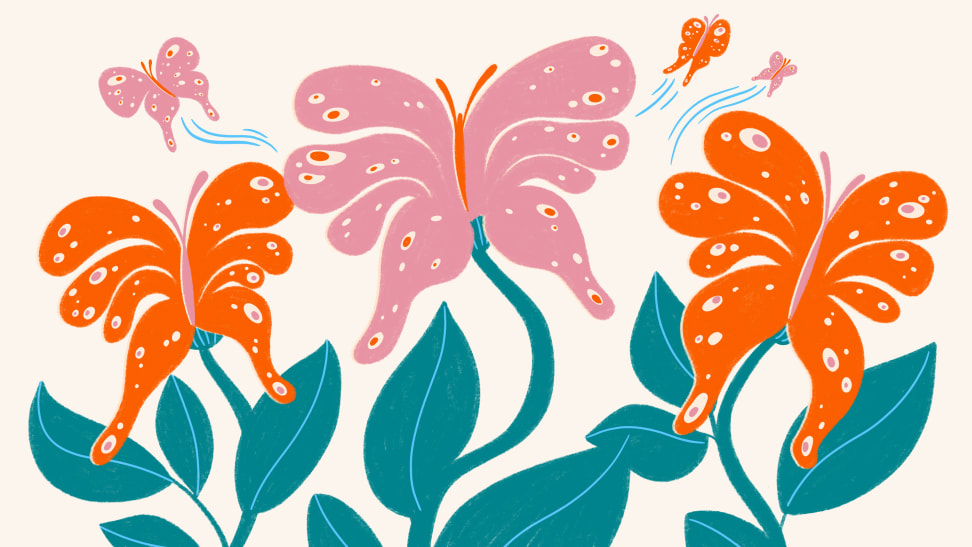 Credit:
Reviewed / Tara Jacoby
Credit:
Reviewed / Tara Jacoby
Products are chosen independently by our editors. Purchases made through our links may earn us a commission.
You can make a butterfly garden anywhere there are bugs—even if your garden is a box on a windowsill or a raised garden bed. A butterfly garden contains a variety of plants that creates a habitat for butterflies to experience a full life cycle—from egg to larva and chrysalis to adult. Butterfly gardens can be a fun and educational experience to teach young children, as well as a delightful way for you to create a safe space for these beautiful creatures to grow and thrive. Plus, you're also helping out other important pollinators like birds, bees, and moths.
Ready to get started? Follow these five easy steps for how to make a butterfly garden.
1. Decide on where to plant your butterfly garden

We like these wood finished flowerpots with three different sizes for your unique butterfly garden design.
The great thing about butterfly gardens is that they can exist almost anywhere. Just make sure to put your garden in a spot that receives a decent amount of sunlight—roughly six hours per day. (Plus, butterflies are cold-blooded insects and love to sunbathe, so they’ll appreciate a sunny spot!)
Options like large planters and pots, like this wooden barrel set with drainage holes, and even raised garden beds can be ideal locations for your butterfly garden.
If you have the space in your backyard and would like to attract a large number of butterflies, you can plant your butterfly garden directly in the ground. Just make sure to grab your garden shovel, like our favorite, the Hooyman Digging Shovel, to help create the holes.
2. Gather your plants and soil

A different variety of seeds and soil to use to create the best butterfly garden.
Native wildlife gardens include easy-care plants with appealing scents that you can find at your local nursery or grow from seed. In general, native plants are easy to grow because they’re already adapted to your local climate. Place plants close together to create your butterfly garden.
If you’re using pots and planters, make sure to get a nutrient-rich soil to help your butterfly garden thrive. Soil like Miracle-Gro Moisture Control Potting Mix is good for keeping potted plants properly hydrated. Want to attract gorgeous Monarch butterflies? Milkweed plants are best for that.
Additionally, purple coneflowers and black-eyed Susans nourish butterflies with nectar in the summer, and feed birds with their seeds over winter. Interestingly, butterflies, moths, and native bees lay their eggs on the flower stems to wait over winter to hatch in the spring.
Additionally, herb plants like parsley and dill are great landing spots for helping butterflies after they hatch from the chrysalis stage, as well as attracting pollinators.
3. Make sure to water your butterfly garden regularly

It's important to have a good water source for any garden.
If you don’t have a sprinkler system to automatically water your plants every so often, make sure to invest in a quality garden hose like the Flexzilla Garden Hose. You may also want a sprayer head, like the Fanhao Spray Nozzle with more than 14,000 Amazon reviews, to help distribute the water in a delicate way.
Or, you can opt for a watering can—just make sure to get one that’s big enough to give your butterfly garden a substantial amount of water, like the two-gallon Cado Watering Can.
We recommend watering your butterfly garden in the early morning, before the sun comes up, so that the water can seep down and penetrate the roots of each plant.
If you have cocoons in your garden, be careful not to spray the plants too hard when watering with a nozzle head, or else you might knock them off. A soft and gentle setting is best.
4. Provide shelter for butterflies

Pop-up butterfly habitats and one-piece clear PVC film is the perfect set to raise a lot of insects, flowers, and plants.
Outdoor creatures like lizards, birds, and mice are known to snack on butterfly chrysalis. In order to maximize the number of butterflies your garden attracts, and protect the ones already living there, try placing a mesh enclosure over your plants. This will keep pests out while allowing your impending butterflies to safely grow.
5. Skip the pesticides

Marigolds and herbs make for a great addition to a butterfly garden.
Avoid using pesticides and chemicals, which may harm the butterflies you’re trying to attract, as well as the pollinators helping your garden flourish. If you want to keep annoying pests at bay, try placing plants that can repel pesky insects without causing harm to butterflies.
Herbs like lemongrass, mint, and chives, as well as flowers like marigolds, are unpleasant to many butterfly plant predators and can help keep them at bay.



